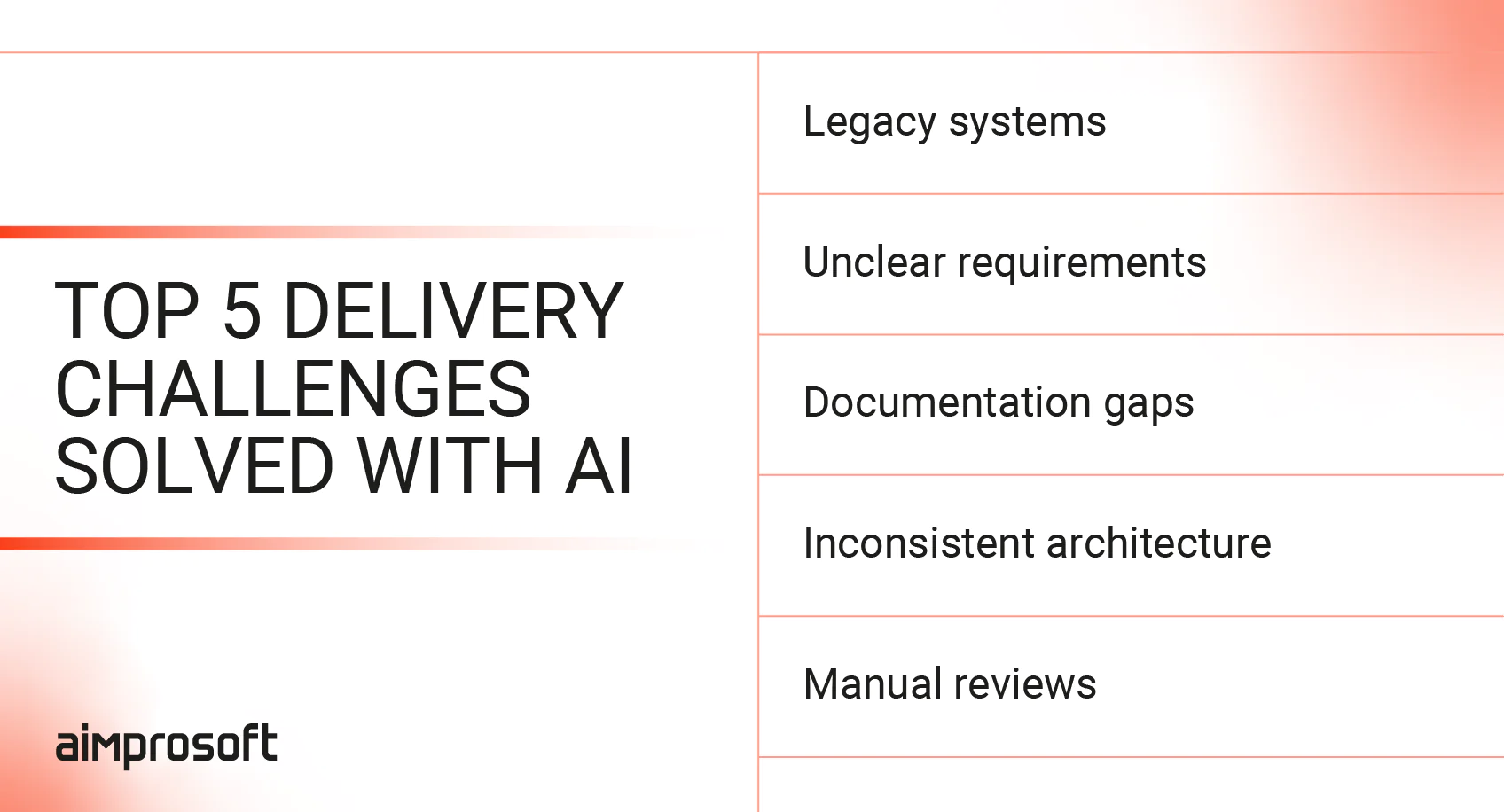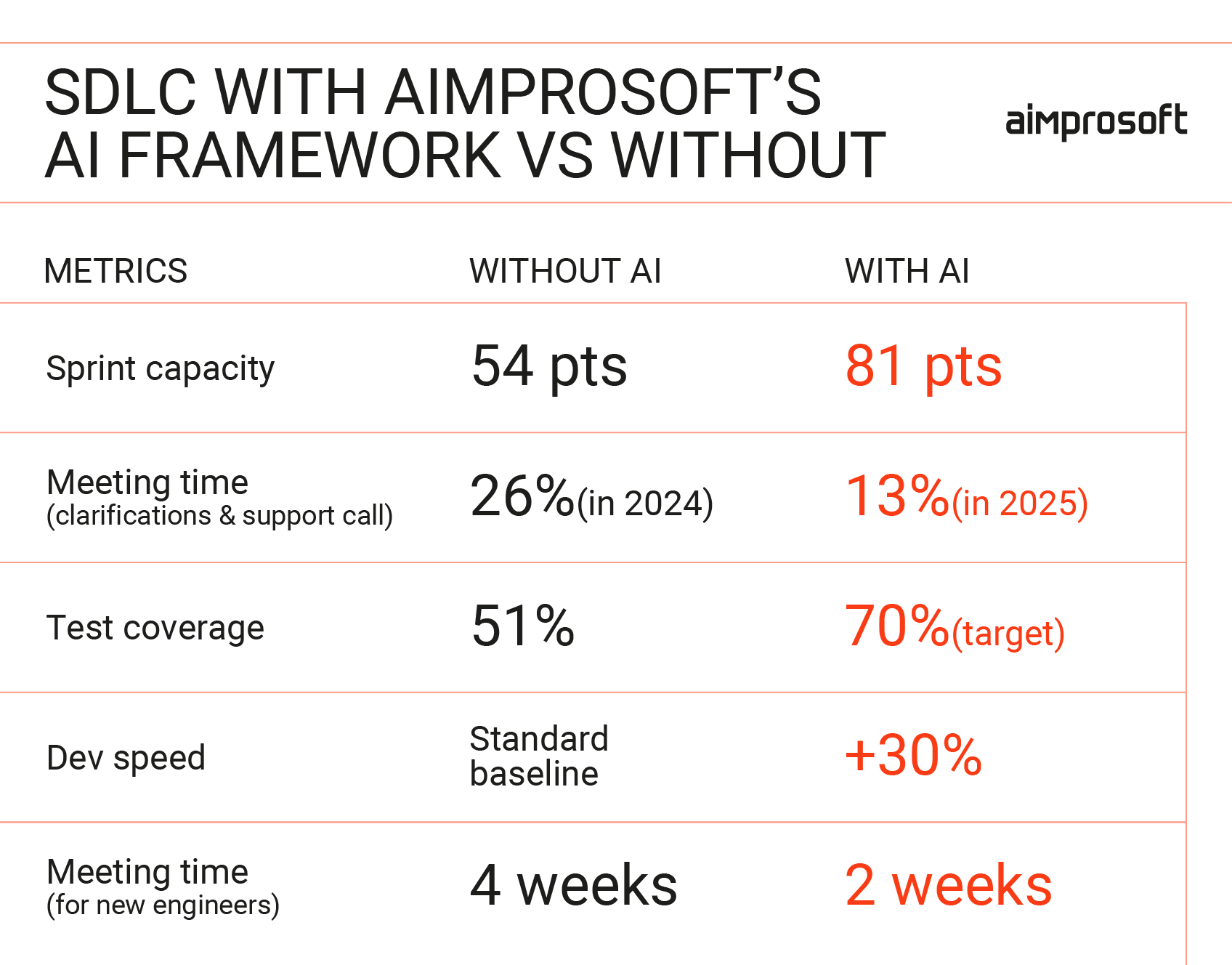AI in Telecom: Boosting Sprint Capacity by 50% with AI Assisted Software Development
Generative AI is rapidly transforming the telecommunications industry, with Deloitte’s 2024 report highlighting its impact across everything from customer service to network optimization. As telecom companies identify optimal AI use cases in telecom, they’re increasingly recognizing that the foundation for successfully scaling these innovations lies in a critical but often overlooked element: software development excellence.
After all, AI-powered support systems, smart routing tools, and digital service portals don’t build themselves. They require engineering teams equipped with AI for software engineering who can deliver faster, ship deliverables of better quality, and collaborate seamlessly across roles.
Okay, so what’s the holdup?
Well, it’s rarely all that straightforward. Many telecom providers still grapple with limited project documentation, legacy codebases, low test coverage, and knowledge silos that slow everything down. These roadblocks don’t just slow down releases — they delay the implementation of real-world telecom AI use cases that could improve both operations and customer experience.
In our collaboration with a well-established telecom partner, we faced exactly this kind of situation. But instead of shying away from legacy systems, scattered documentation, or process inefficiencies, we leaned into the complexity — introducing AI software development services that empowered engineers to deliver faster, reduce overhead, and build long-term agility into their workflow.
Here’s how we did it and the outcomes it gave to our partner.
How knowledge silos held the telecom team back
The telecom partner’s development environment struggled with knowledge silos, which hurt both productivity and tea
m collaboration. Often, the documentation for key system components like classes, APIs, and services was either missing or out of date. This made it hard for developers to quickly switch between different microservices, slowing down the entire process.
Business logic was another blind spot. With little to no documentation, developers often had an incomplete picture of how different services worked, increasing the risk of introducing unexpected problems when implementing new features. This lack of understanding led to hesitation, rework, and delays — a problem reflected in the 2,659 hours (26% of total dev time in 2024) spent on internal support calls and meetings just to clarify requirements and answer technical questions.
These isolated ways of working had a knock-on effect across the entire software delivery process. For instance,
- Business Analysts struggled to fully understand technical implementations, which led to incomplete requirements and an increased number of change requests mid-sprint.
- QA engineers lacked the insight to test functionality thoroughly, often missing edge cases that delayed releases or introduced regressions.
- Developers worked without consistent standards. For example, some microservices used the Lombok library while others didn’t. Naming conventions for code varied widely, and there was no consistent set of basic coding practices being followed.
Architectural inconsistency only made things worse. Different teams used different approaches for managing software dependencies and various versions of libraries. This created compatibility problems that were difficult to diagnose and even harder to resolve. The absence of shared code libraries also led to a lot of duplicated code across different services, resulting in a larger, more complex codebase that was harder to maintain and scale.
One of the most critical concerns was the low “bus factor.” Many components relied on a single person’s expertise — especially in niche areas like performance database optimization. When those team members were unavailable, entire features stalled. These single points of failure slowed development velocity and added to the growing technical debt.
Ultimately, these silos weren’t just slowing the team down, they were making every future change more expensive and every improvement harder to implement.
Solving a challenge like this takes more than just adding developers or QA specialists. It requires a deeper look at how AI and software development could work together in a telecom setting, especially one shaped by legacy systems and highly specialized technical demands. That’s why we introduced the Aimprosoft AI Framework. This approach brings together AI application development services and hands-on development practices that integrate smoothly into complex, existing systems.
Rather than reinventing everything, we focused on where AI for software development could make the biggest difference: automating repetitive tasks, improving visibility across teams, and supporting developers in daily activities like code reviews, testing, documentation, and architecture.
Solving development bottlenecks with AI-powered engineering
After two decades of working with telecom companies, we’ve learned that the biggest blocker to progress isn’t bad code — it’s not getting to write it in the first place.
In this case, developers weren’t held back by complexity. They were stuck clarifying vague requirements, chasing undocumented logic, and sitting through meetings that should have been solved with better tooling and alignment.
Through a detailed analysis of the team’s workflow, we identified nearly a dozen areas where productivity was being lost. By pairing the right AI application development services with clear development practices, we turned those blockers into opportunities for faster delivery, better alignment, and stronger results.

Improving code review speed and quality with AI
Manual code review was slow, inconsistent, and often failed to catch issues that could lead to bugs in production — like missing data checks or logic errors. This meant higher risk of defects slipping through, longer delivery times, and more time spent fixing problems later.
To improve quality and speed, we introduced AI-powered code review tools that automated parts of the review process and enforced consistent standards across the codebase.
What we did:
- Integrated AI directly into GitLab for real-time pull request feedback.
- Created automatic pull request descriptions based on specific code changes.
- Used AI to enforce consistent code style across microservices, reducing noise in reviews and easing onboarding.
- Detected and flagged duplicate code to support the creation of reusable libraries.
Result:
- Review cycles have been shortened from days to hours.
- Significantly fewer bugs are making it to production.
- Code is now easier to understand and update, reducing rework.
Boosting test coverage and security through AI automation
Low test coverage across the partner’s software made it difficult to catch bugs early, increasing the risk of regressions and unstable releases and highlighting the need for more consistent AI software testing practices. At the same time, security checks were handled differently across services — some automated, some manual, and some missing entirely — which left gaps in protection and made it harder to enforce compliance.
We used AI in software testing to improve consistency across test coverage and applied automated tools to strengthen security checks. This helped the team catch issues earlier, strengthen system integrity, and reduce the chances of problems reaching production.
What we did:
- Generated unit and integration tests for Java (JUnit) and Angular (Jest) using AI for software testing.
- Added automatic flagging of missing test cases during code reviews.
- We used AI for QA testing to detect security issues in the code and recommend safer alternatives during development.
- Applied secure logging standards across services.
Result:
- We’re on track to cover 70% of the code with automated tests, up from 51%.
- Security vulnerabilities are now caught before they reach production.
- QA and development teams have greater confidence in release stability.
Unlocking developer productivity by closing knowledge gaps
Poor documentation and inconsistent collaboration were major productivity killers. Developers spent too much time on calls, while QA and BA teams struggled to stay aligned. This led to delays, costly rework, and miscommunication across roles.
We, as an experienced AI software development company, addressed this by automating documentation and surfacing the right technical insights where and when teams needed them — reducing friction, cutting meeting time, and improving delivery speed.
What we did:
- Automated generation of technical documentation in formats like Javadoc, TypeDoc, and Swagger/OpenAPI, covering both code and APIs.
- Used AI to summarize business logic and create structured README files for each service.
- Implemented tools that suggest multiple implementation approaches for common problems to help bridge knowledge gaps.
- Reduced reliance on tribal knowledge through standardized service flow documentation.
Result:
- Reduced time in clarification meetings by 20% in just six months.
- Improved cross-functional collaboration and reduced change requests.
- Cut onboarding time for new developers by half.
Standardizing architecture and scaling operations with AI
Inconsistent architecture and outdated processes were slowing development and driving up maintenance costs. By applying AI to standardize dependencies, streamline CI/CD practices, and unify code structure, we reduced integration issues and technical debt. This created a more stable foundation for faster releases, smoother collaboration, and scalable growth with less risk.
What we did:
- Standardized dependency injection patterns and unified library versions across services.
- Used AI to optimize SQL queries and flag inefficient patterns.
- Enhanced CI/CD pipelines with automated quality checks, Docker caching strategies, and smarter deployment flows.
- Reduced duplication by identifying shared functionality and suggesting common libraries.
Result:
- Fewer integration issues and smoother team handoffs.
- Builds completed 30% faster thanks to improved deployment processes.
- Systems are now easier to update and ready to support future AI use cases in telecom.
Summing up
The gains achieved through our AI software development services speak for themselves. Instead of simply offering more developers, QA engineers, or DevOps support, we delivered a focused solution built around the partner’s real development bottlenecks.

The overall improvements witnessed after implementing our AI-powered software development framework are the following:
- Team capacity increased by 50% — from an average of 54 story points per sprint to 81 points after full implementation.
- Meeting time cut in half — from 26% of work time spent on calls and meetings to just 13%.
- Test coverage improved significantly — on track to reach the industry gold standard of 70% (up from 51%).
- The development process accelerated — 10% faster in the first six months and an additional 20% improvement in the next six months.
The true power of AI innovation in telecom transcends mere performance metrics.
By embedding artificial intelligence into development workflows, telecommunications companies establish an ecosystem of continuous innovation and discovery. Engineering teams, liberated from managing technical debt, can redirect their talents toward exploring new service frontiers. Knowledge previously trapped in organizational silos can flow freely, accelerating decision-making processes and fostering creative problem-solving approaches.
When implemented strategically, the impact of AI on software development doesn’t simply enhance operation — it fundamentally repositions telecom providers as architects of digital transformation, enabling them to shape industry standards rather than merely respond to them.




